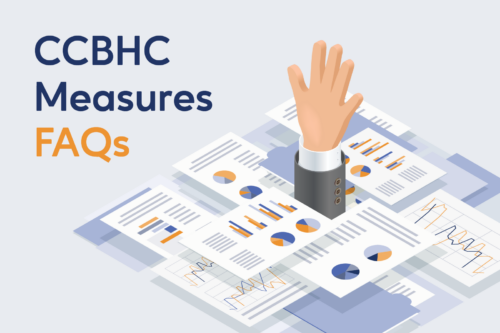FAQ Guide to New and Revised CCBHC Quality Measures

FAQ Guide to New and Revised CCBHC Quality Measures
Revised certification criteria for Certified Community Behavioral Health Clinics (CCBHCs) will require new and enhanced quality measure reporting in 2025, with data collection for some measures beginning as early as July 1, 2024.
Data reporting is a routine compliance requirement for many healthcare providers, but SimiTree’s clinical and compliance experts and data analysts show clients how to do more with the data they’re required to collect.
A few examples of improvements clinics can easily build into their data-collecting processes include:
- Improved processes for easily identifying clients who are eligible for the measures
- Reliable tracking and alert systems to stay within required timeframes
- Use of standardized screening tools and assessments for stronger compliance
“CCBHCs have the opportunity, as they prepare for new quality outcome measure reporting, to leverage their quality outcomes data to improve care, streamline workflow, and drive performance,” said Kathy Dettling, SimiTree’s VP of Clinical Strategy.
Dettling recently joined Melanie Elliott, PhD, VP of Analytics Strategy, to present a webinar explaining revisions to clinic-collected quality outcomes measures under new certification criteria issued by the Substance Abuse and Mental Health Services Administration (SAMHSA) in March 2023.
Their presentation, “Are You Ready for the New CCBHC Measures?” offered detailed information on quality measure changes and offered success strategies to clinics looking to adapt clinic workflows for stronger performance.
View the webinar here.
Are you Ready for the New CCBHC Measures? | Behavioral Health | Webinar (youtube.com)
Grab the complimentary handout here.
No time to view the full webinar? We’ve summarized some highlights from the helpful information Dettling and Dr. Elliott offered in their webinar in a quick FAQ guide to new CCBHC quality outcome measures.
CCBHC Quality Outcome Reporting FAQ Guide
Q. What are the quality measure changes under revised CCBHC certification criteria?
Revisions to quality measures include:
- Required use of a Social Determinants of Health Screening Tool (SDOH)
- Changes to the collection timeframes of depression remission (DEP-REM-6) from one year to six months
- New I-SERV measurement (including the old I-EVAL measure) which measures the number of days between a new request for services and an initial evaluation, the number of days between the first contact to the first service, and the measurement of response time for requests for crisis services.
In addition, revised certification criteria include several “optional” quality outcomes measures. These measures were previously required for reporting and may still be required as part of a specific state’s demonstration pilot:
- Tobacco Use: Screening & Cessation (TSC)
- Suicide Risk Assessment (SR-A and SRA-C)
- Weight Assessment and Counseling (WCC-CH)
Q. Why the urgency? Data reporting won’t begin until 2025.
The effective date for data submission can be misleading at first glance. While it is true that submission of data begins in the measurement year of Jan. 1, 2025 – Dec. 31, 2025, as specified in timelines published by CCBHC PDI and IA grants, it is important to note that there is a look-back period for some of the measures.
This means collecting the data required for the five outcome measures should commence no later than July 1, 2024.
Starting early offers several benefits:
- Clinical Use: You can utilize the data to monitor client progress over time, informing ongoing clinical decisions.
- Preparation Time: Implementing potential modifications to data collection tools and workflows takes time. Starting early ensures you are well-prepared for official reporting in 2025.
Our experts recommend starting preparations immediately to reap these advantages.
Q. What kind of preparation will be necessary?
Changes may be required to a clinic’s workflows, business processes and/or electronic medical records, or other electronic scheduling or billing systems.
This is because data collection, calculation, and reporting of the quality outcome measures will involve both clinical (activity dates/times, screening tools, and diagnosis) and administrative (demographic, coverage type, and claims) data that may currently be available in the clinic’s electronic health record, billing system, or a combination of both.
Q. Why is it important for clinics to use standardized methods of collection under new quality measures?
The use of standardized methods of collection for Social Determinants of Health (SDoH) information and depression screening across all systems of care creates a common language and establishes a definition for levels of depression. Clinics currently making use of various types of depression screening assessments are encouraged to review current assessments and determine which standardized tool will be used for data collection and reporting.
Q. Can telehealth be used for these measures?
Yes, all services and assessments can be completed with screening tools via telehealth, qualifying events, follow-ups, depression screening, SDoH, and PHQ-9 (Patient Health Questionnaire-9).
How SimiTree can help
Need help figuring out how your clinic can ease into new quality measure reporting and optimize performance on each measure?
How SimiTree Can Help
SimiTree’s clinical consultants, compliance experts, and data analysts work with CCBHCs and all types of behavioral health providers to provide guidance and support in standardized methods of collecting, calculating, and reporting required for quality outcomes within specified timelines. Our guidance goes beyond reporting, showing clinics how to leverage data to improve care, streamline workflow, and drive performance.
With specialized tools like our CCBHC Analytics Bundle, we deliver the knowledge your clinic needs for exceptional performance and quality care.
Want to learn more? Fill out the contact form below or give us a call today at 1.866.839.5471.
Discover Related Topics:
CCBHCs can leverage quality data under new certification criteria

